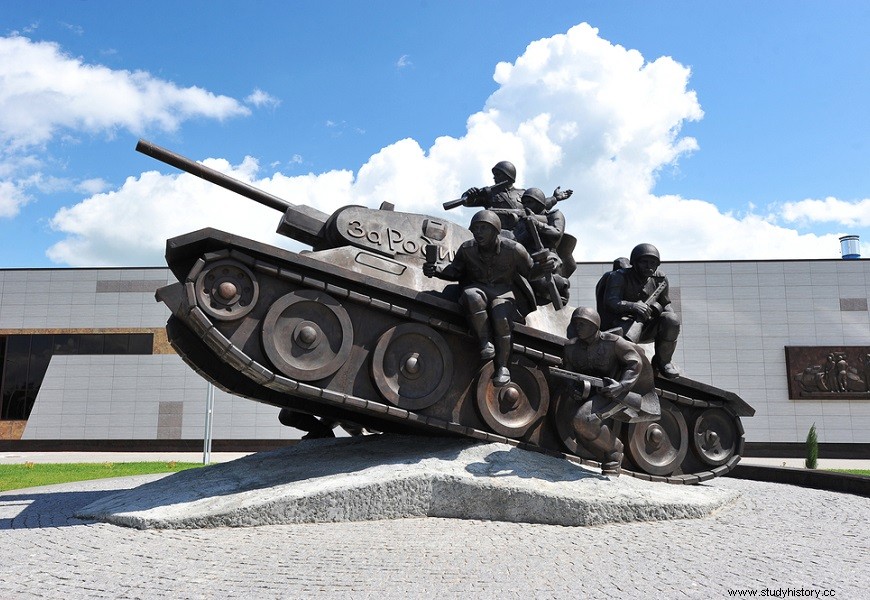
The Battle of Kursk took place in July 1943 during the fighting between Germans and Soviets in World War II. It was planned and started as an attempt by Germany to regain control of actions on the eastern front, becoming known for having the biggest tank battle of the entire war.
Background
In 1943, Germany was experiencing an extremely delicate moment in the war. The victories and advances had stayed in 1942, and what they found now was an uphill struggle and a recovering adversary. Since the defeat at Stalingrad, the Germans had been forced to retreat approximately 800 kilometers from Soviet territory.
In addition to territorial losses, they suffered heavy losses in human life and war equipment. The Soviets, on the other hand, experienced the opposite scenario, for the worst was over, as national industry now supplied the Red Army on a large scale and, every day, more soldiers joined the ranks.
By early 1943, German forces had been positioned in a line of war that stretched for several kilometers and was in the vicinity of the towns of Orel , Kursk and Kharkov . The Germans' idea was to carry out an offensive against a weakened Red Army position near Kursk. From there, they imagined that it would be possible to regain control of the situation in the Soviet Union.
The German attack was delayed by Hitler several times since April 1943. The situation of the fighting in North Africa and the possibility of an Allied attack on Sicily worried the Germans. The postponements were made due to the rains that hit the Soviet Union in the period and because they were waiting for the shipment of armored vehicles that were being manufactured in Germany.
Adolf Hitler ignored some information from German intelligence, which had already warned of a cluster of Soviet troops, indicating that they would be prepared to receive the attack. Hitler disregarded the warning and was unconcerned that the Soviets knew that the Germans would carry out an attack. The Moscow government was already aware of this because the Allied intelligence system (called Ultra) reported on the possibility of a German offensive in the Kursk region.
The attack
The German offensive against the weakened Soviet position in Kursk became known as Operation Citadel and began on July 5, 1943. During this battle, the Russians had 3,600 tanks against 2,700 for the Germans, 2,400 aircraft against 2,000 for the Germans, and 20,000 artillery pieces against 10,000 |1| . In addition, 1.9 million Soviets were deployed to fight 780,000 German soldiers |2| .
The successive delays of the German attack gave the Soviets a chance to bolster their defenses. Thus, several trenches were built, and the anti-tank systems were properly camouflaged in the woods. The Soviets also carried out preemptive strikes with the aim of destroying German aircraft on the airstrips, but to no avail.
When the Germans started the attack, they were surprised that the Soviets were ready to defend themselves. In the early days of the conflict, grandiose air battles took place between German and Soviet aviation. The Germans also made heavy attacks using armored vehicles.
Also early on, the Germans managed to impose themselves against the Soviets and, by the end of the third day of fighting, they had already advanced 29 kilometers |3| . The Red Army suffered a higher number of dead and material losses than the Germans, a scenario that lasted throughout the war. However, after a few days, the Germans' attack weakened, and the Soviets prepared a counteroffensive for July 10, 1943, known as Operation Kutuzov .
It was after this operation began that the Battle of Prokhorovka , in which thousands of German and Soviet tanks faced each other on a gigantic plain. The reports tell of the cloud of dust raised by the vehicles and narrate that the combat between the attacks took place with shots at close range.
On July 13, Hitler called his generals together and announced that Operation Citadel would be canceled under the argument of securing the defense of Italy once the Allied troops had landed in Sicily. As Hitler did not trust the Italians' ability to defend themselves, he ordered troops fighting in Kursk to be deployed to secure Italy's defense. Thus, the Germans suffered yet another bitter defeat on Soviet soil.
Consequences
The German defeat at Kursk cost Hitler's plans dearly. After this failure, the Germans buried their dreams of retaking the path to conquer Moscow and the Caucasus. Approximately 50,000 Germans died , a very small number compared to the Soviet losses , which were 177 thousand in Kursk and 430 thousand during Operation Kutuzov |4| .
|1| HASTINGS, Max. Hell :the world at war 1939-1945. Rio de Janeiro:Intrinsic, 2012, p. 407.
|2| BEEVOR, Antony. World War II . Rio de Janeiro:Record, 2015, p. 529.
|3| HASTINGS, Max. Hell :the world at war 1939-1945. Rio de Janeiro:Intrinsic, 2012, p. 411.
|4| BEEVOR, Antony. World War II . Rio de Janeiro:Record, 2015, p. 544.
*Image Credits:Forden and Shutterstock
